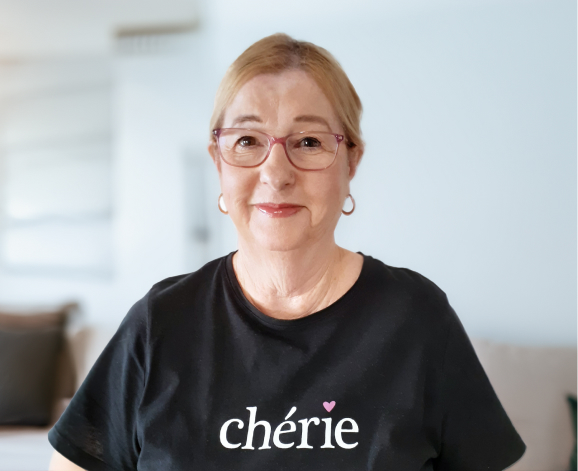After navigating various challenges with home care providers, Suzanne and her husband finally found the quality care they sought. Motivated by their experiences, they now support and advocate for others in similar circumstances. Here’s their story.
Home care can be an overwhelming endeavour, especially for individuals and families just starting out. Fortunately, organisations such as the Older Persons Advocacy Network (OPAN) exist to provide guidance and support.
But there are also community members across Australia who advocate and push for progress behind the scenes.
Suzanne F. didn’t set out to become one of those advocates. However, through her experiences as a care recipient, she has gained valuable insights and is now passionate about sharing what she’s learned with those around her.
Before Suzanne joined The CareSide as a self-managed home care recipient, she and her family had a bumpy care journey that began in 2011, when her husband, Sid, underwent a liver transplant. At the time, the couple lived in a remote area outside of Brisbane. Like many Australians in rural communities, they encountered significant care challenges that eventually forced them to relocate to the city.

Unfortunately, Suzanne and Sid didn’t have much luck with their initial home care providers.
‘When you’re caring for yourself and someone else, you don’t need that added stress.’
‘Oh, they were absolutely hopeless,’ Suzanne says. ‘When you’re caring for yourself and someone else, you don’t need that added stress.’
Payment issues and murky finance operations topped Suzanne’s list of challenges with her previous provider. Despite her persistent efforts to gain clarity and ask questions, she only received convoluted responses in return. When she continued to press for more information, they asked her to leave.
‘I guess I was causing too much trouble,’ Suzanne says with a laugh. ‘It was so bad my daughter helped me file a formal complaint.’
It’s no secret that some companies take advantage of seniors who aren’t familiar with the complexities of home care. Suzanne recognised how untenable the situation had become with her previous home care provider, and while she gained valuable insights from that adversity and ultimately saw her departure as a positive step, it still left her and Sid without adequate care.
It wasn’t long before she connected with The CareSide. The CareSide team sent over detailed information about services and pricing, and Suzanne was delighted with their transparency and honesty—especially regarding costs.
‘[The CareSide] answered all of my questions and they were so well-organised,’ she says.
‘I’ve got the best people around me here. I’m more than happy with how everything’s going.’
Today, Suzanne is a self-managed Home Care Package Level 2 recipient, while her husband is a Level 4 recipient. Most importantly, they’re both receiving the support they need.
‘I’ve got the best people around me here,’ Suzanne says. ‘I’m more than happy with how everything’s going.’

Every Home Care Package requires an approved service provider and an assigned care manager to oversee the package. As a self-managed client with The CareSide, Suzanne has complete control over her home care. She takes an active role in assembling her care plan, overseeing her budget, and hiring caregivers who meet her unique needs and goals.
The CareSide, meanwhile, ensures the services Suzanne receives comply with national standards and legislation. Her personal Care Manager, Ahmed, is a crucial source of support.
‘He responds in such timely fashion,’ Suzanne says as her phone rings in the background. ‘Hold on,’ she tells us during our interview, ‘he’s actually calling me right now!’
In a moment of pure serendipity, Ahmed was calling to check up on Suzanne and Sid.
‘That’s what I mean,’ she says with a laugh. ‘I’ll call him back.’
Suzanne’s appreciation for Ahmed is evident, leading to a conversation about her caregivers.

As a self-managed client, Suzanne has the autonomy to recruit and hire her own caregiving team. When she identifies support workers she’d like to hire, The CareSide handles the necessary checks on her behalf. That includes verifying the workers’ Australian Business Numbers (ABNs), police clearances and insurances, as well as confirming they have the necessary skills to provide proper services to Suzanne and her family.
All of Suzanne’s caregivers draw her admiration, but one in particular stands out.
‘Skye is absolutely brilliant,’ Suzanne says. ‘She competes in triathlons, and every week she takes Sid to the pool for swimming.’
Suzanne explains that all of her caregivers do a little bit of everything—ranging from helping with basic chores around the house to providing transport to social functions—because that’s the type of support she and Sid require.
‘Just leave them and join The CareSide.’
With her care needs met, Suzanne now has the time and firsthand knowledge to advocate for others. She shares stories about friends and family members who’ve had frustrating home care experiences similar to her own. She helps them navigate My Aged Care and search for new home care providers, and she speaks up on behalf of those who are hesitant to speak up for themselves. Many times, she offers this simple advice: ‘Just leave them and join The CareSide,’ she tells people in her community.
Suzanne also attends webinars with the Aged Care Commissioner and continually educates herself about the sector so she can help drive positive change. She’s particularly empathetic toward Australians who are just beginning their home care journeys, understanding firsthand how complicated it was for her and Sid to find proper care.
With that in mind, Suzanne offers these four tips to help those new to home care:
- Start Early: Begin the process even before you need home care. That way you’ll be able to secure support when you need it and avoid getting stuck on a waitlist.
- Do Your Research: Ensure your chosen provider can deliver tailored care to your unique needs and goals.
- Stay Patient: Try not to get frustrated, especially when dealing with unreliable providers. Seek assistance from advocacy organisations for guidance.
- Be Thorough: Be diligent, particularly if you’re new to the system. Some home care companies may provide misleading information; ask plenty of questions so you can choose a trustworthy provider.





